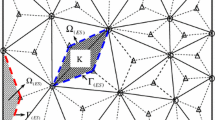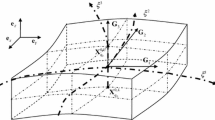Abstract
A stabilized node-based smoothed finite element method (sNS-FEM) is formulated for three-dimensional (3-D) elastic-static analysis and free vibration analysis. In this method, shape functions are generated using finite element method by adopting four-node tetrahedron element. The smoothed Galerkin weak form is employed to create discretized system equations, and the node-based smoothing domains are used to perform the smoothing operation and the numerical integration. The stabilization term for 3-D problems is worked out, and then propose a strain energy based empirical rule to confirm the stabilization parameter in the formula. The accuracy and stability of the sNS-FEM solution are studied through detailed analyses of benchmark cases and actual elastic problems. In elastic-static analysis, it is found that sNS-FEM can provide higher accuracy in displacement and reach smoother stress results than the reference approaches do. And in free vibration analysis, the spurious non-zero energy modes can be eliminated effectively owing to the fact that sNS-FEM solution strengths the original relatively soft node-based smoothed finite element method (NS-FEM), and the natural frequency values provided by sNS-FEM are confirmed to be far more accurate than results given by traditional methods. Thus, the feasibility, accuracy and stability of sNS-FEM applied on 3-D solid are well represented and clarified.



















Similar content being viewed by others
References
Liu WK, Chen Y, Chang CT, Belytschko T (1996) Advances in multiple scale kernel particle methods. Comput Mech 18:73–111
Liu WK, Jun S, Zhang YF (1995) Reproducing kernel particle methods. Int J Numer Methods Fluids 20:1081–1106
Liu WK, Hao W, Chen Y, Jun S, Gosz J (1997) Multiresolution reproducing kernel particle methods. Comput Mech 20:295–309
Gosz J, Liu WK (1996) Admissible approximations for essential boundary conditions in the reproducing kernel particle method. Comput Mech 19:120–135
Belytschko T, Lu YY, Gu L (1994) Element-free Galerkin methods. Int J Numer Methods Eng 37:229–256
Beissel S, Belytschko T (1996) Nodal integration of the element-free Galerkin method. Comput Methods Appl Mech Eng 139:49–74
Nagashima T (1999) Node-by-node meshless approach and its application to structural analysis. Int J Numer Methods Eng 46:341–385
Chen JS, Wu CT, Yoon S, You Y (2001) A stabilized conforming nodal integration for Galerkin mesh-free methods. Int J Numer Methods Eng 50:435–466
Chen JS, Yoon S, Wu CT (2002) Non-linear version of stabilized conforming nodal integration for Galerkin mesh-free methods. Int J Numer Methods Eng 53:2587–2615
Yoo JW, Moran B, Chen JS (2004) Stabilized conforming nodal integration in the natural-element method. Int J Numer Methods Eng 60:861–890
Wang DD, Chen JS (2004) Locking-free stabilized conforming nodal integration for meshfree Mindlin–Reissner plate formulation. Comput Methods Appl Mech Eng 193:1065–1083
Liu GR (2008) A generalized gradient smoothing technique and the smoothed bilinear form for Galerkin formulation of a wide class of computational methods. Int J Comput Methods 5:199–236
Chen L, Nguyen-Xuan H, Nguyen-Thoi T, Zeng KY, Wu SC (2010) Assessment of smoothed point interpolation methods for elastic mechanics. Int J Numer Methods Biomed Eng 26:1635–1655
Cui XY, Liu GR, Li GY, Zhao X, Nguyen TT, Sun GY (2008) A smoothed finite element method (SFEM) for linear and geometrically nonlinear analysis of plates and shells. CMES Comput Model Eng Sci 28:109–125
Liu GR, Nguyen-Xuan H, Nguyen-Thoi T (2010) A theoretical study on the smoothed FEM (S-FEM) models: properties, accuracy and convergence rates. Int J Numer Methods Eng 84:1222–1256
Liu GR, Nguyen-Thoi T, Lam KY (2009) An edge-based smoothed finite element method (ES-FEM) for static, free and forced vibration analyses of solids. J Sound Vib 320:1100–1130
Cui XY, Liu GR, Li GY, Zhang GY, Sun GY (2009) Analysis of elastic–plastic problems using edge-based smoothed finite element method. Int J Press Vessel Pip 86:711–718
Nguyen-Xuan H, Liu GR, Thai-Hoang C, Nguyen-Thoi T (2010) An edge-based smoothed finite element method (ES-FEM) with stabilized discrete shear gap technique for analysis of Reissner–Mindlin plates. Comput Methods Appl Mech Eng 199:471–489
Cui XY, Liu GR, Li GY, Zhang GY, Zheng G (2010) Analysis of plates and shells using an edge-based smoothed finite element method. Comput Mech 45:141–156
Liu GR, Nguyen-Thoi T, Nguyen-Xuan H, Lam KY (2009) A node-based smoothed finite element method (NS-FEM) for upper bound solutions to solid mechanics problems. Comput Struct 87:14–26
Nguyen-Thoi T, Liu GR, Nguyen-Xuan H (2009) Additional properties of the node-based smoothed finite element method (NS-FEM). Int J Comput Methods 6:633–666
Nguyen-Thoi T, Vu-Do HC, Rabczuk T, Nguyen-Xuan H (2010) A node-based smoothed finite element method (NS-FEM) for upper bound solution to visco-elastoplastic analyses of solids using triangular and tetrahedral meshes. Comput Methods Appl Mech Eng 199:3005–3027
Liu GR, Chen L, Nguyen-Thoi T, Zeng KY, Zhang GY (2010) A novel singular node-based smoothed finite element method (NS-FEM) for upper bound solutions of fracture problems. Int J Numer Methods Eng 83:1466–1497
Feng H, Cui XY, Li GY (2012) Static and dynamic analysis of Timoshenko beam using nodal integration technique. Int J Appl Mech. doi:10.1142/S1758825112500457
Wu SC, Liu GR, Zhang HO, Zhang GY (2009) A node-based smoothed point interpolation method (NS-PIM) for thermoelastic problems with solution bounds. Int J Heat Mass Transf 52:1464–1471
He ZC, Liu GR, Zhong ZH, Wu SC, Zhang GY, Cheng AG (2009) An edge-based smoothed finite element method (ES-FEM) for analyzing three-dimensional acoustic problems. Comput Methods Appl Mech Eng 199:20–33
Cui XY, Li GY, Zheng G, Wu SZ (2010) NS-FEM/ES-FEM for contact problems in metal forming analysis. Int J Mater Form. doi:10.1007/s12289-010-0910-1
Zhang ZQ, Liu GR (2009) Temporal stabilization of the node-based smoothed finite element method and solution bound of linear elastostatics and vibration problems. Comput Mech. doi:10.1007/s00466-009-0420-5
Bonet J, Kulasegaram S (2000) Correction and stabilization of smooth particle hydrodynamics methods with applications in metal forming simulations. Int J Numer Methods Eng 47:1189–1214
Timoshenko SP, Goodier JN (1970) Theory of elasticity, 3rd edn. McGraw-Hill, New York
Zienkiewicz OC, Taylor RL (2000) The finite element method, 5th edn. Butterworth Heinemann, Oxford
Acknowledgments
The support of Key Project of NSFC (61232014), National Science Foundation of China (11002053), China Postdoctoral Science Foundation (2013M531780), National Basic Research Program of China (2010CB328005), State Key Laboratory of Structural Analysis for Industrial Equipment, Dalian University of Technology (GZ1212) are gratefully acknowledged.
Author information
Authors and Affiliations
Corresponding author
Rights and permissions
About this article
Cite this article
Feng, H., Cui, X.Y., Li, G.Y. et al. A temporal stable node-based smoothed finite element method for three-dimensional elasticity problems. Comput Mech 53, 859–876 (2014). https://doi.org/10.1007/s00466-013-0936-6
Received:
Accepted:
Published:
Issue Date:
DOI: https://doi.org/10.1007/s00466-013-0936-6




